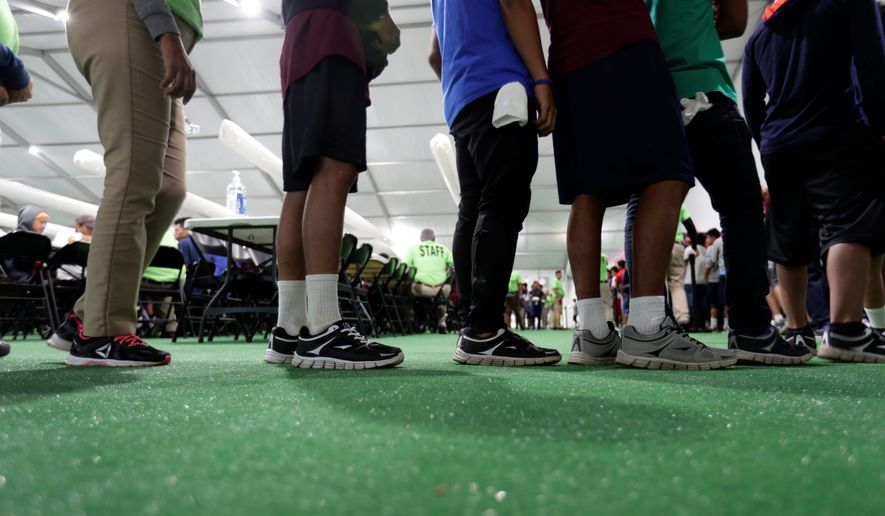Bring a child to the border, get released: It’s a mantra that illegal immigrants have repeated for several years, and groundbreaking data announced Tuesday by the Department of Homeland Security shows just how true it is.
Of the 1 million migrants who showed up as a “family unit,” defined as a parent and at least one child, just 6% are known to have been successfully repatriated. For unaccompanied children from countries such as El Salvador and Guatemala, the repatriation rate was just 5%.
For adults who show up without children, the chance that Homeland Security can deport them is much higher, at 75%.
“The system delivers very different types of outcomes to different types of aliens,” a senior Homeland Security official told reporters while revealing the data.
It’s an immigration loophole consistently cited by security experts and Trump administration officials, but the information released Tuesday is the first broad, systematic look at data substantiating those concerns.
Homeland Security researchers looked at 3.5 million encounters involving unauthorized migrants nabbed crossing the U.S.-Mexico border from fiscal 2014 to fiscal 2019 and tried to figure out what happened to them as of March 31, 2020.
Previous reports looked at encounters and deportations in a single year, but Homeland Security said this is the first time it has looked across agencies and departments and across a spectrum of years to figure out who is staying and who is going home.
The results were sobering.
About 40% of cases that went to immigration courts seven or eight years ago have not been completed. That number is obviously higher for more recent years. More than 62% of cases from 2018 were pending as of March 2020.
When migrants nabbed at the border can be held, they are far more likely to be deported. Just 1% of those held throughout their immigration court cases, usually deemed high-priority cases, are still in the U.S.
Those who are released are far less likely to be ousted. Many of them slip into the shadows and refuse to show up for their court cases.
Even more stunning was the significant number who did show up for their cases, were ordered removed, then were released anyway and never showed up for their final removal, officials said.
“The numbers clearly show detention and removal go hand in hand,” a second department official said. “Catch-and-release simply doesn’t work.”
Acting Deputy Homeland Security Secretary Ken Cuccinelli said the data provides a road map to see “where to close loopholes and more effectively enforce the laws that allow for the removal of illegal aliens and those who are trying to game our immigration system.”
The data was released just weeks before the Trump administration gives way to the Biden administration.
President-elect Joseph R. Biden said during his campaign that he wants to curtail detention and reverse some of the Trump policies that have helped ease catch-and-release. In more recent weeks, though, he has suggested that he will go slow on those plans, fearing he might otherwise spark a new border crisis.
“It will get done, and it will get done quickly, but it’s not going to be able to be done on Day One and lift every restriction that exists and … go back to what it was 20 years ago, and all of the sudden find out we have a crisis on our hands that complicates what we are trying to do,” Mr. Biden said late last month.
Mr. Biden served as vice president during the Obama administration both times when child migrants, known in governmentspeak as unaccompanied alien children or UACs, and families, were surging at the border.
That families and UACs are treated more leniently goes back to federal law, a Clinton-era court settlement and a 2015 court ruling that the Obama administration did not challenge in the Supreme Court.
That latter decision created what security experts call the “family loophole” by setting a 20-day target for releasing children from detention by U.S. Immigration and Customs Enforcement. Releasing the children almost always means releasing the parents, too.
Once they are released, it’s difficult to get them back.
Word quickly got back to Central America in 2018 and 2019, sparking the migrant caravans and the family crisis that sparked complaints of “kids in cages.”
Of the families that came from the key countries of Guatemala, Honduras and El Salvador in 2018, just 2.5% have been repatriated, and 2.4% have won their cases and gained some status.
Two-thirds still have cases pending, and nearly a quarter have been ordered out of the country but haven’t left.
For UACs from those same countries, just 4.4% had been repatriated and 70% were still being processed.
Officials said the numbers might overstate the situation. They tallied known departures, which means that if illegal immigrants were ordered deported, defied that order, then later left on their own, they would still show up as not repatriated.
• Stephen Dinan can be reached at sdinan@washingtontimes.com.




Please read our comment policy before commenting.